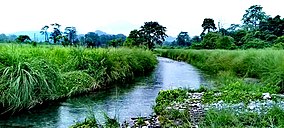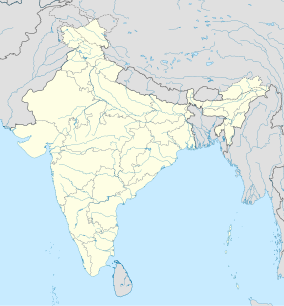Raimona National Park
| Raimona National Park | |
|---|---|
 Western parts of Raimona National Park | |
| Location | Gossaigaon,Kokrajhar District,Assam |
| Nearest city | Gossaigaon |
| Coordinates | 26°39′35″N89°58′34″E/ 26.65972°N 89.97611°E |
| Area | 422 km2(163 sq mi) |
| Created | 9 June 2021 |
| Governing body | Government of Assam |
Raimona National Parkis located in extreme western part ofAssam,India.It is spread acrossGossaigaonandKokrajharsubdivisions ofKokrajhar districtofBodoland Territorial Region.[1]
History
[edit]It was declared aNational Parkon 5 June 2021 by the announcement ofAssam'sChief MinisterHimanta Biswa Sarmaon the occasion ofWorld Environment Dayat Gandhi Mandap,Guwahati.On 9 June 2021; it became as National Park through an Assam Gazette Notification no.FRW.02/2021/27 dtd. 8 June 2021. It is a part of a contiguous forest patch with an area of 422 km2(163 sq mi) covering the northern part of the notified Ripu Reserve Forest (508.62 km2(196.38 sq mi)), which forms the westernmost buffer to Manas Tiger Reserve in the foothills ofEastern Himalaya Biodiversity Hotspot.[2]The present Raimona National Park was originally recommended as Ripu-Chirang Wildlife Sanctuary being part of Ripu reserved forest and Chirang reserved forest being adjacent a part of it was also mooted to be within. Those were made owing to its significance for conservation of Asian elephants, gaur or Indian "bison" and golden langur, all of which have large populations in the area.[3][4][5]It is also part of Chirang-Ripu Elephant Reserve.
Description
[edit]The boundary of Raimona National Park is marked by theSankosh Riveron the west, along the inter-state boundary ofWest Bengaland Assam fromIndo-Bhutan borderup to fire line Ride-6 southwards (BP30) and Saralbhanga River on the east, runs northwards till it touches the Indo-Bhutan international boundary on the north and remaining part of Ripu Reserve Forest on the south. The southern boundary runs eastwards along the fire line Ride-6 up to Pekua River where it runs at 90 degrees southwards till it meets the fire line Ride-3.[6]
The area is located along the Himalayan foothills and together with Phibsoo Wildlife Sanctuary ofBhutanand Buxa Tiger Reserve of West Bengal forms a fairly large trans-boundary conservation landscape of more than 2,400 km2(930 sq mi).[7]
Biodiversity
[edit]

Raimona National Park is famous forgolden langur,an endemic species (with Bhutan) which has been named as the mascot of Bodoland region. It also hasAsian elephant,Bengal tiger,clouded leopard,gaur,chital,four to five species of hornbills, more than 150 species of butterflies, 190 species of birds,[8]380 varieties of plants and orchids.[9]It is already on the global map for being an important bird and biodiversity area.[10]
Wildlife
[edit]Fauna
[edit]Being a moist deciduous and semi-evergreen forest, this National Park is rich in biodiversity. It has four non-human primates,slow loris,Assamese macaque,Rhesus monkeyandgolden langur.[11]Other noteworthy mammals found in this national park includesChinese pangolin,dhole or Asian wild dog,Himalayan black bear,crab-eating mongoose,jungle cat,leopard cat,Asian golden cat,Bengal tiger,leopard,clouded leopard,Asian elephant,gaur,Himalayan serow,sambar,chital,hog deer,barking deer,crestless Himalayan porcupineandhispid hare.[12]
Avifauna
[edit]This sectionpossibly containsoriginal research.(May 2017) |
Raimona forest harbours more than 260 bird species and confirmed presence of minimum 227 avian species that includes 7 globally threatened avian fauna out of which two species were critically endangered such as White-rumped vulture and Slender-billed vulture; five vulnerable viz., Greater spotted eagle, Great hornbill, Wreathed hornbill, Rufous-necked hornbill, Lesser adjutant as well as seven near threatened species. Amongst these, there were a total 43 migratory bird species and 184 were residential bird species as per Choudhury (2000). These include a total 45 species of aquatic birds and 182 species of terrestrial birds as observed in the field and described by Grimmett et al. (2016). Among all the recorded avian fauna, Black-crested bulbul, Black drongo and Golden- fronted leafbird were respectively three highly dominant species found in all the habitat types of Raimona National Park. Passeriformes holds around 116 species (51%) making it the dominant in terms of species richness.[13]Avifauna includescritically endangered white-bellied heron,swamp francolin,kaleej pheasant,grey peacock pheasant,Indian peafowl,Oriental darter,lesser adjutant,collared falconet,slender-billed vulture,white-backed vulture,besra,black baza,Jerdon's baza,osprey,Bengal florican, now perhaps extirpated,ibisbill,green imperial pigeon,mountain imperial pigeon,red-breasted parakeet,great pied hornbill,occasional rufous-necked and grey hornbills,wreathed hornbill,hill mynaandscaly thrush.[14]
References
[edit]- ^"Raimona becomes Assam's sixth national park".The News Mill.2021.Retrieved5 June2021.
- ^"Assam: Raimona declared National Park on World Environment Day".assamtribune.com.The Assam Tribune. 5 June 2021.Retrieved5 June2021.
- ^Choudhury, A.U. (1999). Status and Conservation of the Asian elephantElephas maximusin north-eastern India.Mammal Review29(3): 141–173.
- ^Choudhury, A.U. (2002). Distribution and Conservation of the gaurBos gaurusin the Indian Sub-continent.Mammal Review32(3): 199–226.
- ^Choudhury, A.U. (2002). Golden langurTrachypithecus geeithreatened by habitat fragmentation.Zoo's Print Journal17(2): 699–703.
- ^"Raimona becomes Assam's sixth national park".raimonagoldenlangur.org.The Hindu. 5 June 2021.Retrieved5 June2021.
- ^"Raimona Assam's new national park with rich flora and fauna".raimonagoldenlangur.org.Northeast India24. 5 June 2021.Retrieved5 June2021.
- ^"https://www.guwahatiplus.com/assam/190-different-species-of-butterflies-recorded-in-assams-raimona-national-park".www.guwahatiplus.com/.31 October 2022.
{{cite web}}:External link in|title= - ^"Assam gets its sixth national park, golden langur habitat Raimona".raimonagoldenlangur.org.Deccan Herald. 5 June 2021.Retrieved5 June2021.
- ^Rahmani, A.R. et al. (2016). Important Bird & Biodiversity Areas in India. Vol. 1. Bombay Natural History Society and Bird Life International.
- ^Choudhury, A. U. (1989).Primates of Assam: their distribution, habitat and status.Guwahati: Gauhati University.
- ^Choudhury, A. U. (2013).The mammals of North East India.Guwahati: Gibbon Books and the Rhino Foundation for Nature in NE India.ISBN978-9380652023.
- ^"Raimona National Park » Naparks".5 August 2023.Retrieved2 September2023.
- ^Choudhury, A. U. (2000).The birds of Assam.Guwahati: Gibbon Books and the WWF-India NE Region Office.ISBN8190086618.



